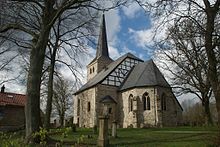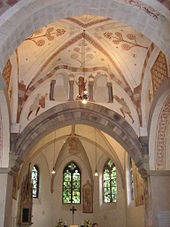Stiepel Village Church

The Protestant Stiepel village church, situated in Bochum's south, in the village of Stiepel, is a cultural monument in the Ruhr area. It has a history of more than a thousand years and thus, is one of Bochum's oldest still preserved building. The church's importance lays most of all in the unusual, extensive medieval wall paintings.
In the year 1988, the church with its surrounding historic churchyard was listed by the city of Bochum. On the 27th of April 1001, Otto III awarded the main estate, belonging to the Carolingian-Ottomanian Reich's estate, which was listed in the in the Benedictine monastery Werden's levy register as villa stipula around 900AC, to the Count Liutger, of the Saxon dynasty Billunger.
Seven years later, Count Liutger's wife Imma, who stems from the dynasty of the Immedinger, received with the help of the Holy Emperor Henry II, the permission to build their own church on the gifted estate. The permission, given by the Cologne archbishop Heribert in a deed of foundation, probably on the 6th of April 1008, contained also the right to carry out of unlimited pastoral care. It is assumed that the church was dedicated by the Countess Imma zu Stiepel, as she was also called, to the Virgin Mary, the Pope Cornelius and the Holy Cyprian.
After the death of Liutger on the 26th of February 1011, Imma moved to Bremen, where she died on the 3rd of December 1038. In her lifetime, she gifted the estate stiplaga, on which the church was standing, to the Bremen Episcopal Church. From there, the estate went to the House of Lippe.
Of the deed foundation, which doesn't exist any more, there were two transcripts made, in the years 1451 and 1708. As these transcripts were also lost, historical research could only lean on written records by Johann Dietrich von Steinen from the year 1757 and by pastor Ostheide from the year 1872.
While in earlier representations of the church, the handed-down texts of the alleged deed text, were uncritically adopted, from 1956 onwards, doubts arose whether the text were authentic. That the handed-down deed text, is in all likelihood a fake, can be found in the analysis done by the historian Stefan Pätzold in 2008. But it doesn't question the time of the origin of the Stiepel village church.
At the end of the 13th-century, the Stiepel church was awarded eight pontifical recollection days in an indulgence letter by Pope Bonifatius VIII from the 22nd of April 1295, which were celebrated on Whitsun and four Mary festivals. A sign, that the old Stiepel pilgrimage church was held in high esteem early on, as the Cistercians of the Mary pilgrimage monastery in Bochum-Stiepel have been interpreted, could not be historically verified.
In 1393, Wennemar Dücker took over the estate Stiepel in connection with Kemnade House from Simon III zur Lippe, followed by Dietrich von Romberg zu Massen, who got both estates as a dowry. After the owner change to Hermann von der Recke in 1418, Stiepel and Kemnade was then family owned by the family von der Recke for over 200 years and finally came to Johann Georg von Syberg by marriage in 1652. His family had the fief until the end of feudal rule, which ended by the Code civil introduced by the grand duchy Berg in the year 1810.
The Reformation started in Bochum-Stiepel in the year 1596. But only in 1610, renounced the then pastor Henricus Cluvenbeck the Roman-Catholic church completely and converted to the Lutheran faith. Since then, the Stiepel village church is a Protestant church.

Today, the Stiepel village church is a hall church with two naves. But in its founding phase, the church was listed as an aisleless church and was turned into basilica in the late 12th-century. At the end of the 15th-century, followed the last rebuilding to a hall church, whereby the chancel was redone in a gothic style, the aisles were enlarged and the east gable of the nave got a half-timbered wall. The tower was raised and a staircase was added on the north side.
The building's whole brickwork consist of the typical local Ruhe sandstone. The bricking was done with processed quarry stones. The church's windows at the top of the main nave are gothic and Romanesque at the tower. The Romanesque windows of the aisles were adapted to the gothic windows of the main nave during the last rebuilding.
Today, there are five bells. Until 1998, the tower had two Bochum cast steel bells and tow medieval bronze bells. the Stiepel village church is decorated will wall paintings from the High and Late Middle Ages. The paintings, in 1698 whitewashed, as an expression of a new prayer attitude, were rediscovered during restoration work in the year 1952. Unfortunately, only inadequately revealed and in parts painted over again. Between 1963 and 1965, all, still preserved paintings were uncovered, restored and conserved. Last restoration work took place in 2002. Since then, the church gives an overall presentation of all original paintings of the 12th tot he 16th-century, which in its form very rarely found in churches in Westphalia.
The paintings, which are open to the public, consist of ornaments, sanctified images and parts from biblical stories. the dominant and oldest part of the painting stems from the time of the construction time of the basilica 1180/90 and relates to the Romanesque epoch of wall paintings. There are the Bethlehem infanticide, the flight to Egypt, the blessing and judging Christ between Kain and Abel and the paradise rivers. Further paintings stem from the early 13th-century, the dragon fight of Saint George from the 15th-century, which is collates to the Gothic art of painting and the disciples, Christ together with the Pharisees, the story of paradise and the birth of Christ from the 16th-century, to name but a few.
(The original text stems from an article of the Free Encyclopaedia Wikipedia

